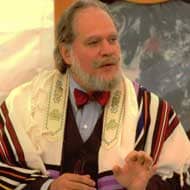Read more about Jewish sacred time here.
After the ten days of awe culminating in Yom Kippur we immediately begin to gather in our last harvest before the winter. We harvest the grapes and olives for wine and light and the spiritual elevation in which both are involved on a weekly basis. We take the produce of our fields using the wood to create temporary dwellings that keep us out of the midday sun. They remind us of a time when palm fronds gave us temporary shelter in the Sinai as we fled from slavery and toward salvation, from fear to faith, from harm to holiness. We call this time Sukkot and it is the last harvest of the year. Everything that we eat from now on will be the stores we have set up beginning in the spring with Nisan and ending now in the fall with Tishrei.
But as Sukkot ends and the long winter begins we take heart in the power of sacred words. We take joy in our Torah with the holy day of Simchat Torah. The cycle of reading for the year ends and begins with this day. As Moshe dies at the end of a long journey, the world is created anew; just as the winter dies and the fields bloom anew in the spring. Simhat Torah is joyous and hopeful as we end and begin again the readings in our Sacred Guide book, Torah.
 After the frenzy of the past few months we slow down with nature and settle in for the long winter. On the 25th day of the winter month of Kislev we look back at the struggles we have faced and the dedication that we have felt. Specifically we think of the Greek oppression manifest in the desecration of our sacred Temple. We light lights of dedication and determination for eight nights, remembering our promise and our commitment that those first lights were not lit in vain. We call this 8-day festival the festival of Dedication, in Hebrew Hanukkah.
After the frenzy of the past few months we slow down with nature and settle in for the long winter. On the 25th day of the winter month of Kislev we look back at the struggles we have faced and the dedication that we have felt. Specifically we think of the Greek oppression manifest in the desecration of our sacred Temple. We light lights of dedication and determination for eight nights, remembering our promise and our commitment that those first lights were not lit in vain. We call this 8-day festival the festival of Dedication, in Hebrew Hanukkah.
Hope is the theme for our year, seasoned with sadness and joy. Some are Holydays of humanity and others are wholly days of nature as in the holyday of T'u B'Shvat, which means the 15th day of Shevat. This is the day when we begin to look for buds, the promise of bloom. We have been lowering our stores, lessening our reserves of food. T'u B'Shvat is yet another holyday of hope, in this case that the earth still follows its cycle as we two-leggeds follow ours. Imagine the giggly joy of watching the first buds peek through the protective bark of trees, long before any of our planted produce gives any indication of life.
 That giggly glee carries us into the month of Adar, the month of merriment. For it is an old saying among our tribe that when the month of Adar blossoms so does our joy. On the 14th of the month of Adar we celebrate Purim, the casting of lots that went a lot better for us than for the evil Haman. On that day we were liberated from the anti-semitic ranting of an Iranian tyrant (in those days it was called Persia). We eat drink and are merry because the worst did not happen and because we are only one month away from our new year, our time of harvest and plenty, our blessing of hope renewed.
That giggly glee carries us into the month of Adar, the month of merriment. For it is an old saying among our tribe that when the month of Adar blossoms so does our joy. On the 14th of the month of Adar we celebrate Purim, the casting of lots that went a lot better for us than for the evil Haman. On that day we were liberated from the anti-semitic ranting of an Iranian tyrant (in those days it was called Persia). We eat drink and are merry because the worst did not happen and because we are only one month away from our new year, our time of harvest and plenty, our blessing of hope renewed.
Reb Bahir has worked with numerous outreach programs, held the post of Executive Director of the Introduction to Judaism Program for the Union of Reform Judaism, and has served as a congregational rabbi. Reb Bahir refuses to be connected with any one movement, preferring to serve the entire spectrum of the Jewish community. He is the spiritual leader of Rocky Mountain Hai, based in Lafayette, Colorado.





